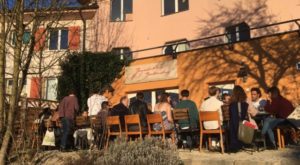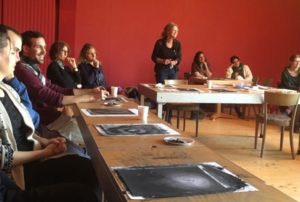24 May Youth Conference on the First Class Lessons – Goetheanum, Dornach April 6-8th, 2018.
Overview
35 youth members of the First Class, from 15 countries around the world, in the age range of 23 to 36 attended the first conference for youth on the mantra of the first class lessons.
The conference was organized and carried by youth section members: Milena Kowarik (Switzerland), Janna de Vrie s (Netherlands), Ioana Viscrianu (Romania), Paul Zebhauser (Germany/Switzerland), Carmen Delia Tromp (Netherlands), Roi Schmelzer (Israel) and Johannes Kronenberg (Netherlands), together with Constanza Kaliks, member of the Vorstand and leader of the youth Section. The content of the conference focused on the first 3 Class Lessons and the themes of thinking, feeling and willing.
s (Netherlands), Ioana Viscrianu (Romania), Paul Zebhauser (Germany/Switzerland), Carmen Delia Tromp (Netherlands), Roi Schmelzer (Israel) and Johannes Kronenberg (Netherlands), together with Constanza Kaliks, member of the Vorstand and leader of the youth Section. The content of the conference focused on the first 3 Class Lessons and the themes of thinking, feeling and willing.
DAY 1
The conference began with a presentation by Johannes and Roi on the evolution of thinking described by Steiner in the content of the Study of Man. A connection was made between the abolition of the spirit during the 8th ecumenical council of Constantinople in 869, and the 17th century philosophical declaration made by Descartes, that the act of thinking causes undeniable being. The famous thesis of Descartes “ I think therefore I am” was brought forward by Steiner in both a philosophical and practical manner to show that thinking can become spirit and give humanity consciousness of the spiritual world. The establishment of doubt as a counter force to spiritual insight was also explored and recognized as the basis of contemporary consciousness.
Following the presentation on thinking, groups explored the questions:
- What is Thinking?
- How does the outer world around you/us affect thinking?
- What is doubt, and where does it come from?
In the evening Rik ten Cate gave a free rendering of the First Class Lesson.
DAY 2
Milena Kowarik started the day with a presentation on the mysterious world of feeling. She spoke about the central place feelings have in-between the poles of human thinking and willing. Connections were made to the yellow-grey beast from the Class lesson, who leads us to mock the spirit, hate others and to lie. Working to counter this spiritual block of our modern age, Michael brings to humanity the possibility of burning enthusiasm and openness for higher knowledge of the spiritual world in and around us.
The questions we explored together in groups were:
- What is it in you that needs to mock, lie and hate (others)?
- How does this feeling relate to the spirit?
- What is “fiery search for knowledge”? What are feelings?
In our artistic exercises that followed, the theme of light and dark was explored using charcoal.
Tour of the Goetheanum
In the afternoon, Rik gave a tour of the Goetheanum grounds, the main hall, the red window, the Hochatelier with the sculptural studies for the wooden Representation of Humanity, and the studio where Steiner died. As the group solemnly stood in the room, Rik spoke up reminding us that Steiner never wanted to be considered or worshiped as a guru. In the same spirit his resting place is a very simple place of experience rather then worship. I enjoyed Rik’s Michaelic distinction. It encouraged me to walk past the vases of roses up to the silk veiled plaster cast of Steiner’s head, made shortly after he died. Looking at the clear vein’s branching out from the edges of Steiner’s eyes to his temples and forehead, I thought about the great contrast between what had lived and entered the world in those veins and the simple building surrounding us. Rik mentioned Steiner also spent a lot of his time in the space working, sleeping and meeting. The walls of the room are simple, rough sawn boards, some parts are aged other parts have been replaced. There are no window openings. Daylight enters from skylights above and the space and atmosphere have little resemblance to the beauty of the architecture in the Goetheanum or surrounding buildings. The contrast gives a heart felt experience of personal sacrifice, selflessness, and a deep commitment to Anthroposophical work.
After the Tour Constanza Kaliks led a free rending of the 2nd class.
In the evening, Carmen Delia lead us through a presentation on the nature of the will, its connection to the forces of karma, our unconsciousness, our sympathies and antipathies.
The three questions Delia posed were:
- Are we free in our will?
- What happens to the will if you are not conscious about it in daily life?
- How does fear freeze you in daily life?
DAY 3
 The last day began with a free render of the 3rd class lesson given by Ron Dunselman. In the artistic exercise that followed, lead by Milou Dunselman, the form of the blue card was studied and created through exercises exploring the difference between curves and straight lines, surfaces and lines, paths made out angles or curves, parallel lines and curvy intersections. The golden colour of the form was also explored and connected to the qualities of the metal gold, the human heart and the spiritual “school” of Michael in the sphere of the sun.
The last day began with a free render of the 3rd class lesson given by Ron Dunselman. In the artistic exercise that followed, lead by Milou Dunselman, the form of the blue card was studied and created through exercises exploring the difference between curves and straight lines, surfaces and lines, paths made out angles or curves, parallel lines and curvy intersections. The golden colour of the form was also explored and connected to the qualities of the metal gold, the human heart and the spiritual “school” of Michael in the sphere of the sun.
In the closing conversation circle, there was an all around emphatic response of reverence and gratitude for what had been experienced and cultivated together over the 3 days. The last words spoken into the circle asked the questions: what will we carry with us into the world and develop further? What can we build on?
Micah Edelstein